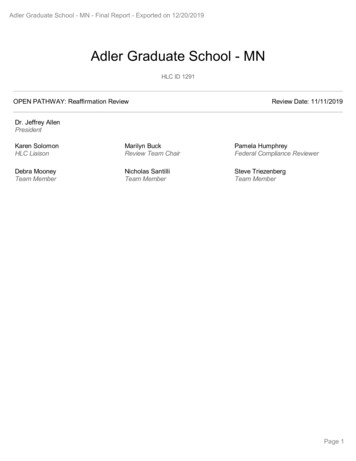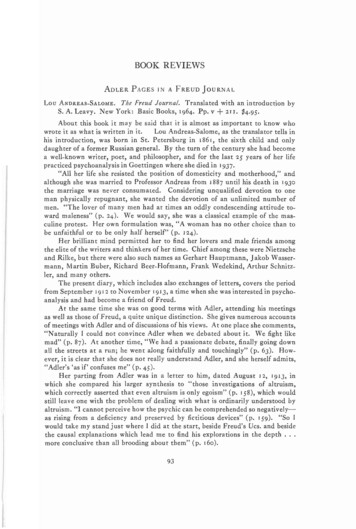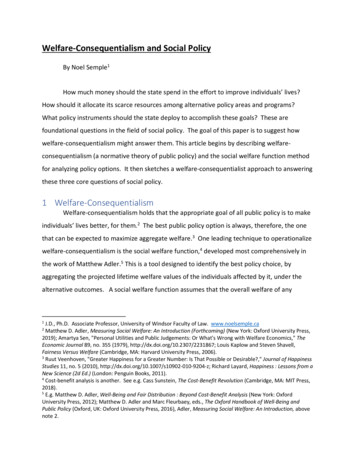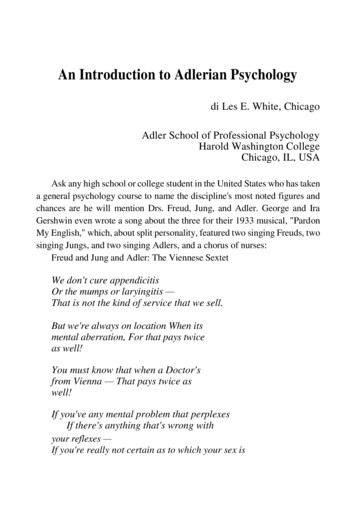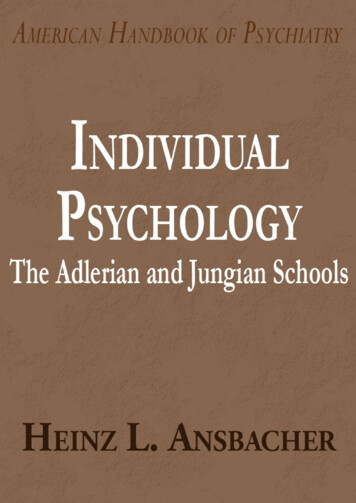
Transcription
AN ANALYSIS OF ADLER’S THEORY AND THE FEMALE CRIMINALElizabeth G. Armentrout, B.A.Thesis Prepared for the Degree ofMASTER OF SCIENCEUNIVERSITY OF NORTH TEXASAugust 2004APPROVED:D. Kall Loper, Major ProfessorEric J. Fritsch, Committee Member andGraduate AdvisorTory J. Caeti, Committee MemberRobert W. Taylor, Chair of the Department ofCriminal JusticeDavid W. Hartman, Dean of School ofCommunity ServiceSandra L. Terrell, Dean of the Robert B.Toulouse School of Graduate Studies
Armentrout, Elizabeth G., An Analysis of Adler’s Theory and the FemaleCriminal. Master of Science (Criminal Justice), August 2004, 94 pp., 1 chart,references, 46 titles.This research paper addressed the following question: Do select case studiesconform to Dr. Freda Adler’s theory regarding socio-economic influences on femalecriminal behavior or dispute her theory? My research involved three female criminals:Karla Faye Tucker, Andrea Yates, and Susan Smith. I addressed Adler’s theory in detail,other theories, the makeup of the female criminal and various female crimes.This study provided evidence that all three case studies conform to Adler’stheory. nIn accordance with Adler’s theory, each of these three females committedcrimes of accessibility. None of the three individuals sought to commit a premeditatedact or to murder unknown victims. They were motivated by emotions arising at a pointin time when access/opportunity presented itself.
Copyright 2004byElizabeth G. Armentroutii
TABLE OF CONTENTSI.INTRODUCTION TO THE FEMALE CRIMINAL. 1The Feminist Critique of CriminologyFemale Criminality According to AdlerAdler’s InterviewApplication of Adler’s Theory to Typical Female CrimesChanges in Female Crime Predicted by AdlerResearch Issue/QuestionII.LITERATURE REVIEW.14Adler’s TheorySocially-Acceptable RolesThe Independence of FemalesDifferences of OpportunityPhysical DifferencesSize and PowerWeapons as EqualizersSex-Employment CrimesGender Roles in Female CriminalityBiological/HormonalFamily MaintenanceExpressions of CriminalityA Sample of Historical Female CrimesA Sample of Different Kinds of Female KillersA Sample of Reasons Why Females Commit Crimes and Motivationsfor KillingContextualizing Female CriminalityGender Ration MeasuresGender Ratios in the Criminal Justice SystemLegal TheoriesStephen J. SchulhoferAnn L. Jacobsiii
Summarizing Adler’s TheoryCase StudiesKarla Faye TuckerAndrea YatesSusan SmithConclusion of the Literature ReviewIII.METHODOLOGY.64Case Study in the LiteratureGeneral Discussion of the Case Study MethodGeneral Discussion of the Qualitative Research MethodPrevious Applications of the Case Study Method in Feminist CriminologyThe Benefits of Selected Case StudiesThis ResearchSelection TechniqueSourcesCase SelectionSelection of Key Characteristics/VariablesAnalysisLimitations of the MethodResearch Issue/QuestionIV.RESULTS & DISCUSSION.74ResultsResearch Issue/Question & AnswerAge at CrimeOnset and Family History of Mental Health ProblemsChildhood AbuseAccess Opportunity, Weapons, and Aggression/VengeanceSelf Defense/SurvivalTrapped/Entangled in Home Duties/MaintenanceInfluences to MurderDemanding Individualsiv
MotivesVictimsSociety ReactionFinal Discussion on Case StudiesV.CONCLUSION & IMPLICATIONS .93ConclusionImplications for Future ResearchImplications for PolicyREFERENCES.99v
I. INTRODUCTION TO THE FEMALE CRIMINALWhy care about the study of the female criminal? Is it possible that the specificstudy of the female criminal has not received the attention it deserves?Or, is itunwarranted because males commit a majority of crimes? One might conclude thatsociety is not totally aware of what crimes are committed by females because we arenot yet ready to completely accept females as criminals.As the female role in societybecomes more influential in all areas, more females are committing crimes.Thosecrimes range from shoplifting to murder and everything in between. The role of thefemale continues to expand in opportunities of choice, most notably in the professionalarena.Females are no longer limited in career choice opportunities.For example,instead of being a housewife, waitress, nurse, teacher, beautician, seamstress orclerical employee, all jobs previously considered only to be occupied by women, thefemale has increased her personal experience and education to obtain employment informerly male-dominated professions such as business, banking, politics, lawenforcement and yes, employment in crime. The change was hastened by the onset ofWorld War II, the women’s liberation movement, and the Civil Rights Act. In WorldWar II, females had to step up to the plate and become the main breadwinners of thehome since men were fighting and defending our country. With the women’s liberationmovement and the Civil Rights Act, traditional female roles changed and new doors ofopportunity opened.1
The Feminist Critique of CriminologyIncreased employment opportunities for females created increased criminalopportunities as well. Is it possible that the study of female crimes has been limitedwhen compared to the study of male crimes?As the female role has ascended insociety, the study of female crime has not kept pace. The reason may be that malesare not yet ready to accept increasingly dominant positions occupied by women.Perhaps, active, prolific study of female crime would imply that society has altered its’focus in that females are no longer perceived as the meek, gentle, small, weak, or quietsex.Further examination into female crime may provide insight into the cause offemale crime (Schulhofer, 1995; Adler, 1975; Mannheim, 1965).We must move forward in the study of female crime. By studying female crime,we can gain insight into the effects of poverty, incest, abuse, poor judgment, lack oftraining, lack of education and mental illness that might cause the female to deviatefrom the path of normal, acceptable, law-abiding behavior. In examining female crime,we are able to develop possible solutions and preventive measures in dealing withfemale crime.Examination of female crime could aid and assist in rehabilitativemeasures for the female criminal (Schulhofer, 1995; Adler, 1975; Mannheim, 1965).2
Female Criminality According to AdlerAdler’s InterviewIn a telephone interview in 2002, Dr. Freda Adler stated that her book, Sisters inCrime (1975) contains case studies from 1971-1974. The book also addresses timeprevious to 1971. Adler saw society’s stereotypical view of women and female criminalsas genetically passive.Adler decided to write her book due to a study she wascompleting on drug treatment centers in the United States.Adler would visit thecenters as part of the research and inquire as to how the women supported their drughabit. Adler was surprised at the women’s responses to her questions. They admittedto robbery, involvement in drug rings, and committing crimes previously thought of asmale crimes.Adler researched and found there were few books written on femalecriminals and decided to write her book. She had hoped it would be published as acollege series book; instead, it was published as a popular book. Adler, through herresearch, surmised that a direct correlation exists between the level independence andequality enjoyed by females and their level of criminal activity (Adler, 2002).Adler thought females were not genetically passive. She wanted to reveal theincreased independence of women and the effects on their criminal activity. Society’sview of the female should reflect social equality. Females should share the same rightsand privileges afforded to men.Increased independence would result in femalesutilizing weapons during criminal activity to compensate for a lack of physical strength.This would permit them to commit crimes normally associated with male criminals.3
Adler sent a warning that female criminal activity would increase as femaleindependence increased (Adler, 2002).Adler traveled the nation discussing her book. She participated in interviews ontelevision and radio. She advised, in these interviews, that the female criminal wouldexpand her activity and begin to commit crimes more similar to crimes committed bymales. Adler advised citizens, scholars, and communities to “gear up,” and be preparedfor the female criminal. She stated, “Times have changed” (Adler, 2002).Adler also stated that new consideration would need to be given to the femaleprisoner. She advised that prison budgets did not account for the increase in femaleinmates. In the 1970s, the United States had female prison facilities insufficient toaccommodate the growing number of female prisoners.The increasing number offemale prisoners was a direct result of increased opportunity and accessibility (Adler,2002).Adler stated in her interview that females commit crimes based on accessibility.Women are shoppers, so women become shoplifters.Women have bodies to market,so women become prostitutes for food, money, drugs, etc. In the 1960s, women wereemployed as clerks in banks so this lead to women committing bank fraud. Her theoryindicates female criminal activity is based on access and opportunity. She provides ananalogy of the law abiding female (legitimate) and the criminal female (illegitimate)(Adler, 2002).Adler describes her theory with the utilization of two ladders.One ladder islegitimate, the other ladder is illegitimate. On the legitimate ladder, women are allowed4
to drive, on the illegitimate ladder women steal vehicles.On the legitimate ladder,women are allowed in bars, on the illegitimate ladder women participate in street fights.On the legitimate ladder women shop, on the illegitimate ladder women shoplift. Onthe legitimate ladder women are bank clerks, on the illegitimate ladder women stealbank funds (Adler, 2002).The analogy of the two ladders is a comparison of law abiding females andcriminal females.She uses the analogy of the ladders to illustrate accessibility andopportunity inherent in a number of situations. The female criminal, as discussed byAdler, does not seek to commit premeditated acts of crime, but is influenced by socioeconomic factors to commit illegal acts. This analogy clearly illustrates the relationshipbetween legitimate accessibility and the opportunity to commit crime (Adler, 2002).Application of Adler’s Theory to Typical Female CrimesIn discussing typical female crimes, we first have to review what is typical.Typical refers to a class or classification in describing a variety of crimes the femalegender tends to commit. According to Adler’s theory, females commit crime based onaccessibility and opportunity inherent in a number of situations. Those situations areoften influenced by the female’s socio-economic status (Adler, 2002, 1975).Typical female crimes include the following (but are not limited to):abandonment of newborn babies, abuse, prostitution, burglary, shoplifting, drugoffenses, terrorism, and murders of children/elderly/or sick. The reason these are5
typical female crimes is because they do not require a great degree of physical strengthwhich is often used by the male in committing crimes. Females tend to commit crimesof opportunity which echoes Adler’s theory of accessibility. Adler also states (2002,1975), physical limitations may affect the role females play in certain crimes if notprovided with weapons to compensate for a lack of physical strength. Should the crimeinvolve some form of confrontation or strength, the female is either acting along side amale accomplice or utilizing a weapon such as a gun to balance her smaller physicalbuild. Additionally, the female may use deceit in acts of murder, or robbery. Thedeceit could be displayed in many ways including the poisoning of her victim.(Roberts, 1993; Leonard, 1982; Heidensohn, 1995; Hickey, 2002; Richie, Tsenin, andWidom, 2000; Nagel and Johnson, 1994; Pollak, 1950; Adler and Simon, 1979).In the following, we discuss examples of typical female crimes. These examplesof female crimes are based on opportunity as espoused in Adler’s theory.Theapplicability of Adler’s theory will be discussed at the end of each section in relation toeach example offered.Abandonment: If a father abandons his children, he may simply leave the careof the children to the mother and avoid criminal responsibility.The father is notchastised by society in leaving his own children nor does he go to jail for such an act ofabandonment. However, if a mother abandons her children, she is held accountable bysociety and punished by law.Females who deviate from the norm of society arepunished upon committing a criminal act, such as abandoning their children.Thefemale not only is punished by law but punished by defying her gender norm (Roberts,6
1993). According to Adler’s theory (2002, 1975), the mother may become stressed,financially distraught, or sick and decide to abandon her children. The opportunity todo so is constantly available.Abuse: The abuse of children occurs more frequently in lower socio-economicenvironments where females had children and did not have education, assistance ortraining to provide for the offspring emotionally, mentally, physically and spiritually(Lopez-Rey, 1970).Additionally, law punishes females if the father abuses a child.Society considers this abuse as a failure of the mother to protect her child and establisha secure home environment (Roberts, 1993). In relation to Adler’s theory (2002, 1975),abuse is a crime readily accessible for a mother to commit upon her children. Thefemale does not look for the action of abuse to take place, meaning it is notpremeditated.The abuse may be a response caused by the female’s childhoodbackground (upbringing) and passed down from generation to generation.Prostitution: A female chooses prostitution due to needs and necessities. Theneeds may be social and/or economic. The female may have no other way to obtainmoney for food, clothing, and shelter. The female’s childhood influences the decision tochoose prostitution. That choice may be an indirect result of childhood sexual abuse orwhether her mother chose to be a prostitute to make ends meet for the family (Adlerand Simon, 1979).Prostitution is the oldest female profession. Some individuals may assume thatprostitutes come from lower levels of society such as subsidized housing. However, itcould be the female’s background, such as childhood sexual abuse, that may cause her7
to choose prostitution. Also, economic benefits could push a female into this profession(Heyl, 1974).Prostitution falls directly in line with Adler’s theory (2002, 1975).Females use what is accessible in order to gain economic benefit. This accessibility isselling the female body to willing individuals in order to purchase necessities. Accordingto Adler, this crime is not for sexual benefit.Burglary: Burglary usually involves a forced entry and may not offer solitude forthe female offender. The crime of burglary is fraught with unplanned possibilities thatmay result in confrontation. According to the authors, females generally do not committhese crimes alone. They are primarily accomplices, offering assistance as a lookout orvehicle driver. These crimes may involve confrontation and females commit most oftheir crimes in secret (Adler and Simon, 1979).This crime, with respect to Adler’stheory (2002, 1975), is accessible especially if the female is employed as a housekeeperor is acting as a backup individual for a male to commit the crime. With regard toburglary, the female may be aware of when an individual is away from the residence orbusiness and will set a time for the crime to be committed. The female could possiblyhave associations with the owners which provide accessibility and opportunity tocommit the crime.Shoplifting:Shoplifting involves the common theft of day to day items.Females usually commit these crimes alone and against entities with whom norelationship is shared, such as department stores or grocery stores.Additionally,females may find it easy to steal office supplies or household items from an employer(Adler and Simon, 1979). Shoplifting aligns with Adler’s theory (2002, 1975), due to8
the act of females shopping for provisions. The shopping provides a straightforwardopportunity to commit a crime.Drug offenses:The typical addiction is passed down from generation togeneration. Some females become addicted to prescription drugs and purchase thesedrugs on the street or through fraudulent prescriptions. Drug addiction may alleviatethe pain of reality. It is also influenced by other factors including social, environmental,and in certain situations, customs, background, and religion. (Adler and Simon, 1979).Drug offenses are factored into Adler’s theory (2002, 1975) because of access to pills inthe home, stores, office, or from other individuals.Terrorism: Females are usually involved in a support capacity in such activitiesas terrorism. The female usually aids the male in being able to sneak into a city orcommunity and terrorize victims. It is difficult for society to see the female in terms ofthis violent act of horror. Females are not normally viewed by society as cold-heartedkillers. However, females are competing for the male role of dominance and educatingthemselves among the ranks. With their cunning, deceptive and masked ways, thefemale terrorist can be more deadly then the male terrorist (Cooper, 1977). In applyingAdler’s theory (2002, 1975), a female may be seeking acceptance and choose tocommit this crime; however, this is a crime which does not totally align with Adler’stheory. Adler does state as females’ progress in their independence, their crimes wouldbe more similar to male crimes.This crime appears to involve premeditation whileAdler’s theory is based solely on accessibility and opportunity. But, according to Adler,once females become more independent, their crimes would increase in severity.9
Murder: Murder by a female usually involves someone involved in a relationshipwith the female. Unlike their male counterpart, females do not seek out or stalk theirvictims. A female murderer’s victims are usually male companions, spouses or children.In some cases, the murder occurred due to a violent argument with an intimate orhostility toward a child. Other cases of murder involve premeditated actions such aspoison or a shooting due to an affair or future divorce (Adler and Simon, 1979; Ward,Jackson and Ward, 1969).According to Adler, female criminals have a relationshipwith their victims, thereby providing an opportunity for the crime. This crime could becaused by mental illness, sexual or emotional abuse, rejection by family members orpeers, financial difficulties or other similar factors.The typical crimes females commit seem to be based on accessibility more sothan premeditation, which conforms to Adler’s theory. They seem to be involved incriminal activity through opportunities arising from social, environmental, cultural,professional, background, and religious influences. According to Adler (2002, 1975),the female criminal desires personal gain, as does her male counterpart; however, theopportunities for access have been different.With the increase of independence,training, and education, the variance between female and male criminal activity isdiminishing (Adler and Simon, 1979; Ward, Jackson and Ward, 1969).10
Changes in Female Crime Predicted AdlerAre Adler’s predictions true? Would more females be committing crime with theirincreased independence since the publication of her book in 1975? According to theBureau of Justice Statistics, the annual prison admissions for females has increasednearly 700% from 1980 – 2001. Approximately 14,000 females were admitted in 1980and approximately 95,000 females in 2001. Females accounted for 4.1% of the totalprison population in 1980, and increased to 6.7% in 2001 (Adler, 1975; Greenfield andSnell, 2000; Beck, Karberg & Harrison, 2002).In 1991, a national prison survey found that two thirds of female offenderssentenced for a violent crime had murdered or attempted to murder someone withwhom they shared a close relationship. Violent male offenders, on the other hand, tendto seek out victims who are strangers. The difference in violent acts between femalesand males appears to be relationship between the offender and victim. The results ofthis study indicate violent crimes committed by females are perpetrated againstindividuals to whom the females have regular access. This supports Adler’s accessibilitytheory (Snell, 1991; Bureau of Justice Statistics, 1994).11
Research Issue/QuestionThis research paper will address the following issue/question: Do select casestudies conform to Adler’s theory regarding socio-economic influences on femalecriminal behavior or dispute her theory?Adler’s theory relates to the roles females play in society.Society looks onfemales as the frailer sex. Society believes that the female could not possibly commitcrimes equal to that of her male counterpart.environment and access.Females commit crimes based onFor example, in the past, female crime primarily includedpoisoning, infanticide, adultery, and incest. As females gained more independence insociety, their access to more serious criminal opportunities increased (Adler, 1975).There are many issues and questions surrounding the female offender; however,my concentration and focus will be in responding to the following:Do select casestudies conform to Adler’s theory regarding socio-economic influences on femalecriminal behavior or dispute her theory? I trust with the research and the evidencepresented that useful information might be shed on the topic of the female offender.This information could possibly be used for future research into effectively dealing withthe female offender through prevention of crime, punishment for crime andrehabilitation of the offender.My research and examination deals with three select studies of violent femalecriminals: Karla Faye Tucker, Andrea Yates, and Susan Smith. The reason I chose tostudy these specific female criminals was that research revealed similar patterns linking12
their motives, accessibility to their victims, weapons chosen, socio-economicenvironments, independence, and acts of violence.Adler’s theory maintains thatfemales commit crime based on accessibility. She also discusses the female gender andhow society views this gender as opposed to the male counterpart. In the followingsection, I will be addressing Adler’s theory in further detail, other theories, the makeupof the female criminal and various female crimes.13
II.LITERATURE REVIEWThis literature review serves to offer insight into Adler’s theory of the femalecriminal. It addresses socially-acceptable roles and the effect of female independenceon female crime. It covers differences of opportunity, physical differences, size andpower, weapons as equalizers, sex-employment crimes, gender roles in femalecriminality, biological/hormonal effects, family maintenance, expressions of criminality,a sample of historical female crimes, a sample of different kinds of female killers, asampleofreasonswhyfemalescommit crime andmotivations for killing,contextualizing female criminality, gender ratio measures, gender ratios in the criminaljustice system, legal theories and case studies.It presents other criminologists’research and ideas regarding the female criminal. It further addresses legal theorists’opinions on female offenders.With the exception of one, these theorists appear toparallel, with some differences, Adler’s views of the female criminal, society’s perceptionof the female criminal, the study of female crime, and female incarceration. They eithersupport Adler’s view or they convey new information that supports her view.Theopinions of only one of the selected theorists, Cesare Lombroso, do not align withAdler’s view.Lombroso’s theory, developed in the mid-1800s, serves to offer pastinsight into the examination of the female criminal. He is placed in this section for ahistorical perspective on the study of the female criminal and his interesting thoughts ofthe female criminal.14
Within the discussion of each theorists’ and legal theorists’ opinions, there is atopic comparison analysis concluding each of the sections. This final analysis discusseswhether the opinions of said individuals align or differ from Adler’s theory. The sectionafter presentation of family maintenance addresses expressions of criminality.Thissection discusses a sample of historical female crimes, a sample of different kinds offemale killers, a sample of why females commit crime and motivations for killing. It isby no means a complete explanation of the female criminal, but sheds light into whomthe female offender might be and why she might choose to deviate from the path of alaw abiding individual. This review covers a selection of material that may help us tobetter understand past, present, and future female criminals. It serves as a prelude tothe final section of the literature segment on my three violent female killers and studiesfor their crimes.The last section of the literature review addresses case studies. This sectiondetails each of my three selected female criminals. It relays only facts on each casestudy. An introduction on my three female case studies begins with their place of birth,progresses to their childhood upbringing, discusses their socio-economic influences andfinally, describes their specific criminal acts of violence.The literature section reflects my research using reference books, the Internet,law journals, and magazines. The section is derived from various sources and does notserve as a complete guide on the female criminal.It simply offers a sample inexamining the female criminal and who she might be.15It is presented with great
respect for the individuals whose research and ideas I draw from and will hopefully bebeneficial to those who follow in this area of research.Adler’s TheoryAdler discusses the beginning of time with the role models of Adam and Eve.Adam’s role was to cultivate the soil and acquire food.Adam was responsible forproviding a secure home for his wife and children keeping them safe from outsideelements. He was to work outside of the home, develop the land, gather fruits, gathervegetables, and hunt prey. Eve was responsible for items inside the home. Eve’s rolewas to reproduce and her social role was accepted as submissive under Adam. Eve wasto wash, clean, sew, cook, and provide other necessities that Adam desired inside thehome. Eve’s position in life was secondary to Adam’s. If Adam did not work outside ofthe home there was nothing for the family to eat.Adam’s position was thereforeprimary. Adam secured a place for the home to be safe and Eve created a home to restin safety. In addition to Eve’s home duties, Eve was the only one to reproduce. Thisrole bound Eve to the home because the child must be cared for inside the home andEve’s duties remained inside and tied to the home. Therefore, the socially-acceptablerole for females in society was established as being submissive and secondary to themale (Adler, 1975).16
Socially-Acceptable RolesBefore World War II, socially-acceptable roles for females primarily included thedomestic housewife, the community supporter and the welfare recipient. The domestichousewife took care of household chores and cared for the children. She also aided inwhatever services were requested by her husband. The housewife was responsible forcreating healthy, well-adjusted children that would eventually grow up as adults andbecome acceptable members and supporters of society (Heidensohn, 1995).The community supporter developed outside informal groups. She tended to thesick such as the mentally ill/handicapped, disabled, and elderly. She served as craftmaker, midwife and wise woman. She was considered the bond of the community.Those who were unable to support their community or themselves were dependentupon welfare (Heidensohn, 1995).The welfare recipient possessed no other means of support. She would receivethe support of the community and government with donations of clothes, food andother necessary items. It was socially unacceptable for the traditional welfare recipientto seek employment outside her home to support her children. The children needed tobe cared for by her and no one could be a substitute for the mother caring for her ownchildren.Additionally, if the welfare recipient chose to be employed outside of thehome in order to make ends meet, she was thought to be neglecting her own children.If the neglected children strayed from acceptable society forms of behavior and became17
delinquent, the mother would be blamed for this delinquent behavior because sheworked outside of the home (Heidensohn, 1995).Topic comparison analysis: Heidensohn echoes Adler regarding society’s view ofand role assignments for the female gender. Heidensohn also addresses the female’srole as being the caretaker of the home and not the provider for the home.Heidensohn follows the same line as Adler in that females may not stray from theacceptable dictated behavior that society orders.The Independence of FemalesIn World War II, men were called away to represent their country. While themen were away fighting for the country, a vacancy was left in jobs those menpreviously filled and women were called upon to fill this vacancy. The female role insociety changed substantially with war. A number of females were no longer
MASTER OF SCIENCE UNIVERSITY OF NORTH TEXAS August 2004 . Armentrout, Elizabeth G., An Analysis of Adler's Theory and the Female . Additionally, the female may use deceit in acts of murder, or robbery. The deceit could be displayed in many ways including the poisoning of her victim. (Roberts, 1993; Leonard, 1982; Heidensohn, 1995; Hickey .





